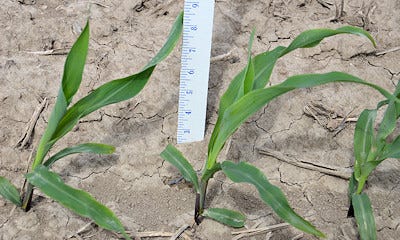
If you are new to Crop Watch, it’s a simple project where one field of corn in the central part of the Corn Belt is followed all year long. Both good performance and problems that show up in this field just might show up in your field. By investigating them here, perhaps you can pick up insights for your own field.
Seed Consultants, Inc., helps sponsor this project. Look for more details on the project itself coming soon.
Crop Watch 4/18 - Use common sense on early planting this year

PLANTER TIME NEARS: Follow a few simple steps to get a great stand for 2016.
We’ve been highlighting what the farmers who farm this field have done to prepare for the season over the past few weeks. The goal is evenly-spaced corn, which emerges together, producing even height early in the season. Here are 5 steps this farm operation has taken to increase the odds that will happen.
1. Inspect the planter and make any repairs before season started
Their 24-row planter was ready to go long before soli conditions and the calendar were right. They have a relatively new shop, designed large enough to being in a planter, unfold it and work on it row by row. It was field-ready!
2. Pick correct hybrids to pair together
Their preference is to fill 12 boxes with one hybrid and 12 with another in every field which they farm. They believe that gives them some risk assurance. The goal is to pick two hybrids that will mature at about the same time, but which have a couple days’ difference in flowering time so they can spread out the pollination period. They buy seed from several companies, and work closely with seedsmen to make sure they match hybrids correctly.
3. Wait until soil conditions are right to plant

EYES ON THE PRIZE: Here is what the Corp Watch farmers want in their quest for top yield. They want a uniform stand in terms of both plant spacing and emergence, leading to uniform height at the stage of the season pictured here.
Their goal every year is to start planting April 15. But if soils aren’t ready by April 15, they don’t start. They want to avoid planting too wet. It makes it harder to close the seed slot properly, even though they do minimum tillage. They also want to avoid creating soil compaction if possible.
Crop Watch 4/11 - Expect pH to vary in fields where soils aren't uniform
4. Spend as long as it takes on opening day to get things adjusted correctly
Even though they intend to have the planter field-ready, the proof is in performance. That may mean doing some digging behind the planter, and keeping an eye on monitors to make sure they are getting the seed spacing and proper seed drop that they want.
5. Load variable-rate seeding prescriptions into computer guiding planter and go.
They’ve become firm believers in variable-rate seeding for corn. The Crop Watch field is primarily one soil type, but has a small amount of both a more productive soil, and a less productive soil. They will set up the field prescription to change seeding rates accordingly.
About the Author(s)
You May Also Like




